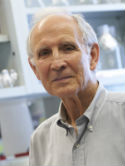Primary structure of c-kit: Relationship with the CSF-1/PDGF receptor kinase family--oncogenic activation of v-kit involves deletion of extracellular domain and C terminus Journal Article
| Authors: | Qiu, F.; Ray, P.; Brown, K.; Barker, P. E.; Jhanwar, S.; Ruddle, F. H.; Besmer, P. |
| Article Title: | Primary structure of c-kit: Relationship with the CSF-1/PDGF receptor kinase family--oncogenic activation of v-kit involves deletion of extracellular domain and C terminus |
| Abstract: | The protein kinase domains of v-kit, the oncogene of the acute transforming feline retrovirus HZ4-FeSV (HZ4-feline sarcoma virus), CSF-1R (macrophage colony stimulating factor receptor) and PDGFR (platelet derived growth factor receptor) display extensive homology. Because of the close structural relationship of v-kit, CSF-1R and PDGFR we predicted that c-kit would encode a protein kinase transmembrane receptor (Besmer et al., 1986a; Yarden et al., 1986). We have now determined the primary structure of murine c-kit from a DNA clone isolated from a brain cDNA library. The nucleotide sequence of the c-kit cDNA predicts a 975 amino acid protein product with a calculated mol. wt of 109.001 kd. It contains an N-terminal signal peptide, a transmembrane domain (residues 519-543) and in the C-terminal half the v-kit homologous sequences (residues 558-925). c-kit therefore contains the features which are characteristic of a transmembrane receptor kinase. Comparison of c-kit, CSF-1R and PDGFR revealed a unique structural relationship of these receptor kinases suggesting a common evolutionary origin. The outer cellular domain of c-kit was shown to be related to the immunoglobulin superfamily. The sites of expression of c-kit in normal tissue predict a function in the brain and in hematopoietic cells. N-terminal sequences which include the extracellular domain and the transmembrane domain as well as 50 amino acids from the C-terminus of c-kit are deleted in v-kit. These structural alterations are likely determinants of the oncogenic activation of v-kit.(ABSTRACT TRUNCATED AT 250 WORDS) |
| Keywords: | oncoprotein; genetics; proto-oncogene proteins; molecular genetics; mouse; animal; cytology; animals; mice; gene; proto oncogene; genes; epidermal growth factor receptor 2; platelet derived growth factor receptor; protein tyrosine kinase; rna; gene expression regulation; dna; amino acid sequence; molecular sequence data; cat; cats; nucleotide sequence; base sequence; receptor, erbb-2; protein-tyrosine kinases; chromosome deletion; isolation and purification; retrovirus; retroviridae; receptors, platelet-derived growth factor; chromosome map; chromosome mapping; cell surface receptor; receptors, cell surface; proto-oncogenes; hybrid cell; hybrid cells; colony stimulating factor receptor; humans; human; article; receptors, colony-stimulating factor; mlcs; mlown |
| Journal Title: | EMBO Journal |
| Volume: | 7 |
| Issue: | 4 |
| ISSN: | 0261-4189 |
| Publisher: | Wiley Blackwell |
| Date Published: | 1988-04-01 |
| Start Page: | 1003 |
| End Page: | 1011 |
| Language: | English |
| DOI: | 10.1002/j.1460-2075.1988.tb02907.x |
| PUBMED: | 2456920 |
| PROVIDER: | scopus |
| PMCID: | PMC454427 |
| DOI/URL: | |
| Notes: | Article -- Export Date: 6 August 2020 -- Source: Scopus |
Altmetric
Citation Impact
BMJ Impact Analytics
Related MSK Work





